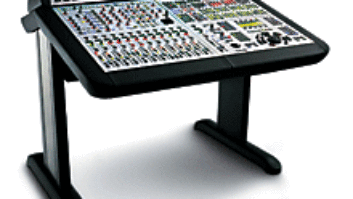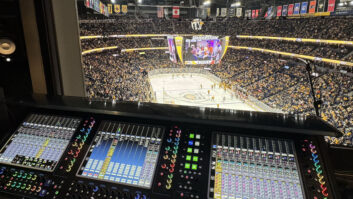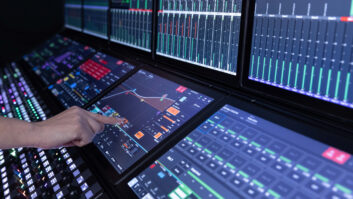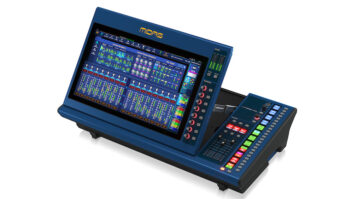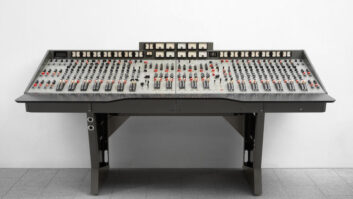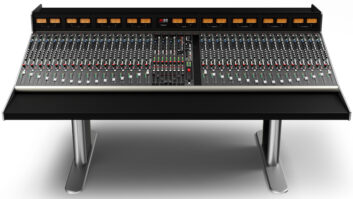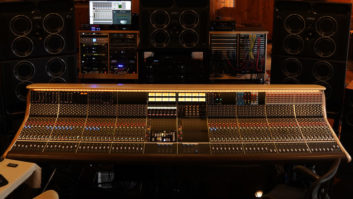Purchasing a console, especially a big-ticket one, has never been easy. Previously, choosing which console to buy wasn’t that difficult: There weren’t that many out there, and they didn’t perform that many functions. For your high-end studio, you picked from among two or three manufacturers and bought the latest, biggest, baddest, sexiest model you could afford. For your mid-priced studio, you bought used. For your demo room, you got some small version of a live mixing board.
Today, with prices of large-format consoles approaching seven figures, and shakeups in the leasing business narrowing options, studio owners have to put a lot more thought into what they need from a desk. As for that demo room — well, it’s now a full-fledged studio, capable of turning out a finished product. And among the decisions for it are: Do you even need a console? If you do, there’s a bewildering array of choices.
In the high-end market, sometimes success comes from sticking with the tried and true. Kevin Mills owns Larrabee Studios (L. A.), which, during the past 10 years, has grown from two rooms to three facilities with seven rooms. Mills has mainly avoided the agony of console indecision; his core business traditionally has been mixing, and he has stuck with Solid State Logic. When he decided to also get into the tracking business two years ago, he purchased a facility, now called Larrabee East, already fitted with two classic Neve 8078s that were left in place. Presently, Larrabee North houses three SL9000 Js, while West has hung on to Studio A’s popular E Series and is in the process of upgrading Studio B to SSL’s latest, the K Series.
“I’ve had people suggest certain consoles,” Mills comments. “For example, Fletcher at Mercenary Audio in Boston has been trying to talk me into the Rupert Neve 9098, which he absolutely loves. And, certainly, the new Neve console has its admirers. But we purchased our first SSL in ’79, when there was only one other in the city, and because of that, we’ve pretty much developed an SSL mixing clientele. We’ve just extrapolated on that, especially since the J Series, which, because of its sound quality, won over a lot of people who didn’t like SSL.
“Until we got Larrabee East, though, I wasn’t aware of the amount of people who still wanted to mix on Neve 8078s. Studio X there has been one of our most successful rooms. I get calls asking if I’m ready to sell [the consoles], but instead I’m adding on. We made the 32-in tracking console a 40-in, and we’re getting new Martec Flying Faders for it, because a lot of the people who want to mix in there want them. There were other options, but I’m not trying to sell people on new technology. I’m just trying to provide something they want to work with.”
About his decision to be one of the first to take possession of SSL’s latest incarnation, Mills says, “Buying the K was a natural progression. I still do not own a digital console, even though people tried hard to convince me. Digital technology is a completely different dynamic for the recording studio investor. Look at our Studio B with its E Series, which still works great. People love it, the room is booked. Or take the 8078s, which were built in the 1970s. Good analog consoles maintain their value and their functionality, whereas digital technology can go from being extremely expensive to being worthless in a second. What’s a 3348 worth now? A Mitsubishi X850? You can’t sell them. The same occurs with other digital technology.
“The average studio owner buys a console and finances it over four years. But you count on there being residual value after four years, and that you will get return on your money over more years. There was no way I could buy a $700,000 console that I knew had a high probability of being worthless at the end of four years. You can’t make money that way. So I went with the J in 1998, and the K is the same technology, just improved — better bandwidth, better functionality, a much faster computer that will support lots of new software and better suited to surround mixing.”
That said, Mills admits that in his business, surround capability is not presently a necessity. “To be perfectly honest,” he states, “it’s completely unimportant. Our Studio 3 is one of the only fully 5.1 surround mix rooms with large monitors in L.A., and in three years, we’ve never turned on the system. Although I think that’s going to change, and certainly I want to be prepared for it.”
Mills offers the opinion that certain vintages of analog consoles are more likely to maintain their value. “Everybody knows that there are certain bad years for a car,” he asserts. “For consoles, the same is definitely true. When you have a lot of SSLs, you find that there are certain years that, for whatever reason, just don’t sound as good. The G that we had in Studio A at West was just not one of the good Gs. It always sounded thin. We put in a J, but now, since we were redoing A, we decided to go with the K. Meanwhile, the old E in Studio B is clicking on all cylinders, and if it’s not broke, you don’t fix it.”
The fact that the K Series is not backward-compatible with the J for mixing is not an issue for Mills. “Generally, our clients want to do their recall in the same room that they did the original mix in,” he says. “And, certainly, if I’m going to invest in a new console, I’d rather it be the next generation.”
About his brand loyalty, Mills comments, “Some people get different consoles, and if they have a clientele that likes them, that’s great. My clientele is more, ‘I need a J to mix on. I’ve just got a call to mix for four days and I need to get in somewhere where studio issues aren’t a concern. I want monitors that I’m used to, a Pro Tools system that doesn’t crash, and well-maintained consoles that I can just sit down and work on.’
“These days,” says Mills, “we are constantly focused on one thing: offering more for the same price. Costs go up, but if you have the volume of business, you pay down your debt and you run the business conservatively and efficiently, you can do it. I firmly believe that, upcoming, the key to profit is all about value-added. There’s going to be a shakeout, and to stay in this game, you’re either moving forward or you’re falling behind.”
The Hit Factory New York and The Hit Factory Criteria Miami comprise 13 studios and six mastering suites. Although not a total Solid State Logic operation, SSLs definitely dominate their landscape. In April of this year, the New York operation will take possession of the East Coast’s first two K Series.
“We do have other consoles,” notes CEO Troy Germano, “two Sony Oxford digitals, one Neve 8078 that was part of Criteria in Miami when we acquired it, one Neve VR, and two Euphonix System 5s, which we are currently building rooms for. The two 9000 K Series will be going into two new studios at our 421 West 54th Manhattan facility.”
Germano doesn’t agree that the music industry isn’t ready for digital consoles. “The Sony Oxfords have a following,” he says, “and they do very well. We were the first in New York with it, back in January of ’98. And when we completed our renovation of The Hit Factory Criteria in April of 2001, we opened Studio F, a new room built for another Oxford.
“We have a lot of clients who are very loyal to the Oxfords, and we’re going to try to develop a clientele for the Euphonix System 5,” he continues. “But we’re also very excited about the SSL K Series. It really is an enhanced 9000 J, and for our needs, that will be ideal.”
Germano agrees that surround capability is not a key factor in his console decisions. “It’s not a big part of our business, but it’s important to us,” he offers. “We will be equipped for it. Obviously, the J Series can handle 5.1 mixes, and the K Series can handle all formats. We’re prepared, and if it becomes a big part of our business, that will be a pleasant surprise. For us, the important features on the K Series are the remote mic preamps and the faster computer. Those are what people are going to be attracted to right off the bat.”
In The Hit Factory’s quest to stay on the technology forefront, Germano has made concessions to the digital world, but he’s adamant that an analog SSL remains the industry workhorse. “It’s true that the lifespan of some digital technology can be equivalent to a laptop,” he acknowledges. “If you have clients that want to work on it, that’s the chance you take. Because we have multiple rooms, we are able to try new technologies, but it can take a lot of persuading and work sometimes to get others to understand the benefits of a digital console.
“That’s why I still feel the best consoles for what we’re doing, day in and day out, are the 9000 Series. SSL provides great service and support, they build a great product and they listen to what their clients have to say. We purchased our first console from them in 1984. We’ve now purchased 25 consoles; that says a lot.”
Issues are different on the Central Coast; Chicago Recording has 12 studios in two different buildings, servicing clients in music, television and radio commercials, audio for picture, surround mixing and DVD authoring. In 2001, CRC also opened the soon-to-be three-room Glenwood Place in Los Angeles. According to executive VP Hank Neuberger, CRC accommodates that diverse work with a variety of consoles, including Neve, SSL, Harrison, AMS/Neve Logic, Euphonix, Yamaha and Amek Rupert Neve.
“Different markets have different needs,” he contends. “In our music rooms, the clientele likes to see Neve and SSL consoles. In post-production and audio for picture, the clients are not as locked in. For those markets, we tend to let our staff engineers have a lot of input into what tools they need to satisfy their clients. That makes for a little different purchasing decision; we can go with a more individualized approach. It’s the engineer’s needs that I’m primarily interested in.”
For Neuberger, the physical footprint of a desk also comes into play, as does post-production’s more ready acceptance of digital consoles. “Post-production has moved into digital consoles a lot faster than music recording,” he notes. “We’ve had excellent results with digitally controlled consoles in that area for a long time: our Harrison 10 and our Euphonix 2000 and 3000. Those engineers are doing back-to-back sessions and need to be able to instantly recall intricate setups; when that type of product came out, it was a big breakthrough. I also think they’ve embraced digital consoles in that area, because a lot of our work in those rooms ends up on video, which is virtually all digital now. The clients are expecting that their audio is handled in a digital domain as much as possible also.”
CRC owns two digital Euphonix System 5s, and according to Neuberger, has been very successful with them. “Control rooms for post tend to be a little smaller,” he explains. “One of the great things about the System 5 is that the 8-module buckets have only two wires coming out of them: a power cord and an Ethernet cable. We were able to build our own custom frames that not only coordinated with the look of the room, but could be customized to maximize the space. We got a smaller footprint with a very sophisticated group of functions.
“It’s ironic, really,” he comments. “In a music room, the mixers still like to be spread out across the room; they still like consoles with 72 or 80 I/O. Post mixers don’t have any of that [type of] hangup. With digital and digitally controlled analog consoles, you can get 80 inputs on a very small desktop. Actually, with the Euphonix, you can do 80 inputs on one fader! Having 24 faders that give you ready-access to 96 inputs is a real asset with the Logic or the System 5.”
Neuberger finds the easy interface to hard disk recorders another plus for digital consoles. “These kinds of studios have relied on hard disk recording even longer than music rooms, so interfacing those recorders with the consoles readily has been a plus. Music studios still like analog consoles, and I don’t blame them. When you’re patching dedicated effects in and out — this vintage compressor, that particular mic pre — it makes sense to keep your audio in the analog world. But for post, digital consoles definitely are an advantage.”
At CRC, surround capability is increasing in importance, but is still not a primary concern — analog or digital. “Out of our 12 Chicago rooms, we have surround capability in three,” Neuberger says, “although we can set it up in any room. It is something we’ve been sensitive to in the past two years, making sure that anything we buy has the necessary busing and monitoring facilities for surround.”
At Glenwood Place, CRC’s L.A. branch, the consoles are a System 5, an Amek/Rupert Neve 9098 and, upcoming, an SSL 9000. “Different tools for different jobs,” says Neuberger. “The System 5 is set up with a D-to-D link to a large Pro Tools system. It’s perfect for mixing to picture and surround. The 9098 we put in because we think it’s the best-sounding console Rupert Neve has ever been associated with; the golden ears guys really loved the sound of it and also feel that its automation is state-of-the-art. The SSL 9000 is a proven, accepted, top-of-the-line choice, especially in the Los Angeles market. You have to listen to your customers. If that’s what they want, then that’s what we have to give them.”
For some time, The Village Recorder in West Los Angeles has been a fully Neve facility. But, according to CEO Jeff Greenberg, remaining all-Neve was not the primary reason he decided, in October of 2001, to make The Village one of the first to take delivery of a Neve 88R. “We wanted to go with whatever had the best sound,” he insists. “We really hadn’t even planned to upgrade, because a lot of people, especially our film clients, liked the VR Legend that was in Studio D. But when we started listening, the 88R sounded so beautiful that we just had to do it. It was important to me to be able to say to our clients that we are providing them with the best-sounding console made today.”
To facilitate his decision, Greenberg sought the opinion of engineers he respected, such as Al Schmitt, Steve Kempster and Nathaniel Kunkel, even sending Kunkel to England to assess the 88R prototype. “They all agreed that it sounded great,” he says. “Al Schmitt has gone on record as saying it’s the best-sounding board he’s ever heard.
“Robin Porter at Neve was involved with the construction and design of the original 8048s with Rupert,” he continues, “the last board that Rupert really worked on. And the 88R is Robin’s design all the way through. We had a lot of confidence, and also we had a part in it. We had modules out to us two years before the release of the desk so that Al and Steve, among others, could listen. They did listen, they made suggestions and a lot of those suggestions were executed. When we got to the stage of final listening, which I would never buy without doing, we really felt that the product was extraordinary.”
Besides pure sonics, other criteria for the choice were familiarity of operations and flexibility for the console to work well in applications from rock music recording to film mixing. The 88R’s remote 1081 mic preamps were also another factor; The Village’s package included 36. And for Greenberg, unlike for some other decision-makers, surround capability was a primary requirement. “We do a lot of television and film mixing in that room,” he comments, “and we needed to be able to handle all the variations of stereo and surround.”
Being one of the first to purchase a newly designed console is a bold move; Greenberg sees the 88R’s uniqueness as a plus, but not as a deciding factor. “The fact that the 88R was unique was not part of my criteria,” he states. “But I do feel that with so many SSL 9000s in town, they are bound to start weighing on each other. Again, our decision was ultimately about the sound. The vintage Neve that I have in Studio A has been called, by many people, the best-sounding console they’ve ever worked on. I wanted to have something good enough for those people to go back and forth on, and I think that’s something we’ve done.”
Traditionally, Cherokee Studios in Los Angeles has made stubbornly independent console choices. “We’ve always prided ourselves on the sonics of our consoles,” says VP and co-owner (with brothers Bruce and Joe) Dee Robb. “So for a number of years, we’ve traded a shortage of inputs and functions for sonic quality. But it got to the point where we realized we couldn’t continue to make that trade-off and be competitive. The possible solutions, such as sidecars, were not at all elegant. We even toyed with the idea of constructing a console, which we’ve done before and know is a horrific experience. None of those options seemed reasonable.
“We had two things to accomplish: We didn’t have a viable mix room; the only console we had with a lot of inputs was the Otari Advanta DSP desk, which just isn’t universally accepted. We also wanted to upgrade our tracking room.
“At the time we started looking, the Neve 88R wasn’t yet available, so it really came down to an SSL 9k or a G Plus. SSL made several studios available for us to do mixing, and we also polled our regular clients and people like Toby Wright, who, although he liked to track on our A-Range, had never mixed with us. Interestingly, the people that we polled liked the 9k better for tracking but heavily preferred the G Plus for mixing. And that was our reaction, too. With the G Plus, there is definitely a sound, and it’s one of the rare occasions where I have to say that adding a sound is not a bad thing! Normally, our feeling has been that we want everything — the recorder, the monitors, the console — to be as transparent as possible. So, in a way, there are a lot of things about the SSL that go against our philosophy of ‘less is best.’ But the fact is, for the mixing process, you put your program up on the G and there’s this sound that’s really good. And this isn’t very technical to say, but there’s also a bigger gratification factor with the G Plus; you crank the EQ, and it really does what you want it to.
Having decided on a G before SSL began building the Classic, the only option was to buy used, and a deal was struck to have the desk they decided on — the “Bluestone,” formerly owned by The Hit Factory — completely refurbished by Professional Audio Design. [See Sidebar, “The Pre-Owned Option,” for more on Professional Audio Design.] Cherokee is another facility actively involved in surround mixing, so that capability was a necessity. The Bluestone G had already received some surround mods at Hit Factory, and Cherokee also added a PAD surround monitor matrix.
For the tracking room, the Robbs felt it was important to achieve the kind of transparency they’d enjoyed with their Trident A-Range desks. Before deciding on an API Legacy, they went through an extensive round of blind testing with different manufacturer’s modules. “We listened to everything, and we could always tell which was the A-Range,” says Robb. “When we listened to the API, we thought the API guys and our engineer were tricking us — having us listen to the same thing twice. We couldn’t tell them apart, and that was very exciting. The other aspect was that once we switched in the equalizer and the dynamics, it brought in all of the wonderful API character. We pretty much on the spot decided that was the way to go.
“Even though we’d listened to modules, we were nervous until we actually had it in the room and turned on, because sometimes things change when you put it all together in a big console. But after the first session, we high-fived each other. It sounded great. We also love the functionality of it. It doesn’t have quite the automated features of a 9000 or the 88R, but it’s a really intelligent tradeoff. It has the relatively pristine signal path we wanted: Only three amplifiers in the chain as opposed to 16 or 18, and those three are discrete. Paul Wolff, the chief designer, really did an incredible job. It has the features and functionality that the A-Range didn’t, but we were able to keep the high sonic level, so we’re thrilled.”
Up in San Rafael, Calif., on Lucasfilm’s Skywalker scoring stage, Leslie Ann Jones, director of music recording and scoring, has been evaluating the options. “You have to look at a finite amount of time for use of a console now,” she comments, “not only as a business decision — depreciation and how soon you can make your money back — but also just in terms of useability. We’ve made the decision to go with another analog console. There are still a lot of unresolved issues with digital, not the least of which is being boxed in by sampling rate. We have clients who can’t take advantage of high-sample recording formats because they choose to mix on digital consoles that are 24/48. Personally, as an engineer, I never want to get boxed into that. Nor do I want our clients to be. An analog console allows you to go to any format. We do have another room in the music and scoring department that has a Euphonix System 5, but I’d rather keep that as an alternate for now, for several reasons, including sample rate and familiarity.
“For us,” she continues, “there are only two choices: a Neve 88R or an SSL 9000 K Series. We have been a Neve facility for a long time, and our clients tend to be more audiophile. They’re not the typical function-oriented SSL G and E Series users, so until now, we were never able to consider SSL as an option. That’s changed with the 9000 Series. I think the 9000 K and J users are more fidelity-conscious than the traditional SSL user, and that’s more our marketplace. Also, SSL has done quite a lot of research and work in this area, and their consoles are used on many scoring stages.
“Both of those consoles have very flexible 5.1 capability straight out-of-the-box, but we still need a scoring panel with a flexible matrix — which they both offer — but, of course, adds to the cost. We’re also looking at remote mic preamps, another extra charge. Because of the music that we do, and who our clients are, there are things that end up being options for us, such as gold switches, that a more traditional recording studio might be able to forego. Other options for us have to do with scoring, like being able to split the auxes up between one side of the console and the other, so that if you have an orchestra on the left side of the console and a rock band on the right, you effectively double your amount of sends.”
As far as footprint goes, the decision has been made to stick with 72 inputs, with the possibility of adding a digital sidecar. “A small Sony or the new Yamaha would provide us with some instant recall of panning and the kind of radical stuff that people working on 5.1 mixes sometimes want to do,” Jones says. “You can’t do that with an analog console, but you don’t need 144 inputs for it. You only need a dozen or so to cover those things in a mix that you might want to fly around the room or do radical EQ changes with.”
Given all the above considerations, ultimately, according to Jones, a major deciding factor will be the final price of the console and its options package. “Being Skywalker Sound notwithstanding,” she states, “we have a finite amount of money to spend and we have to spend it as wisely as we can. We are looking at something that’s going to last five or six years before we make a switch. We’re hoping by then that digital consoles will become such that we can put them in and not worry about limiting our clients’ options.”
Maureen Droney is Mix‘s L.A. editor.
